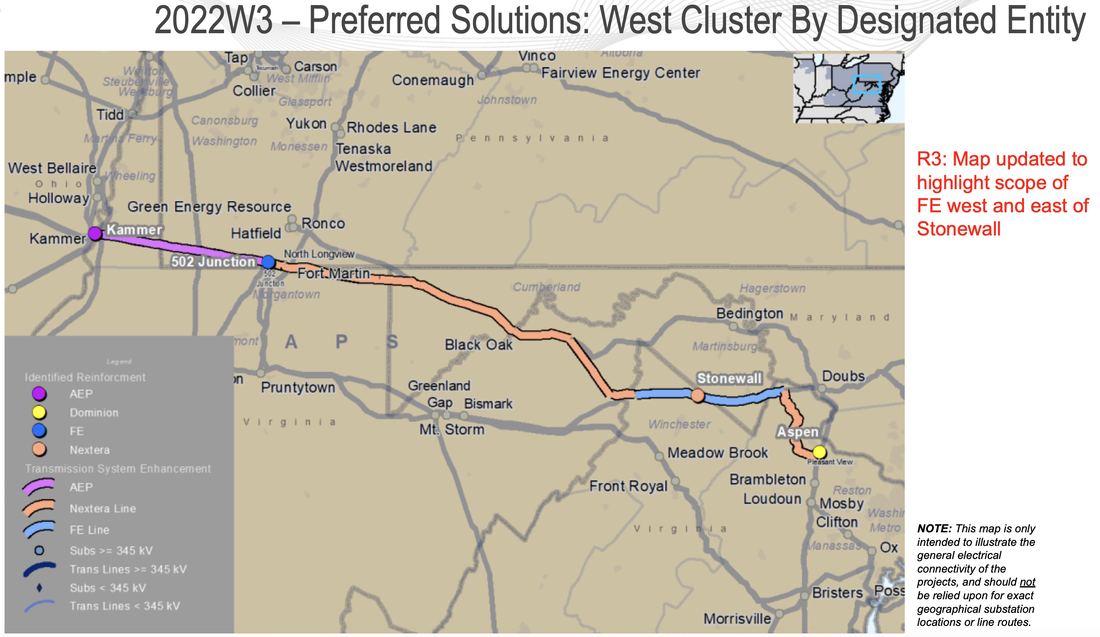So, how DO utilities develop proposed routes? Here's a look at how they developed the proposed routes for the proposed, but never built, PATH transmission project 15 years ago. Utilities still use the same process today.
| path-lre.pdf |
The Routing Team developed specific routing criteria in identifying, evaluating, and selecting routes, attempting to minimize:
Route length, circuity, cost, and special design requirements.
The removal or substantial interference with the use of existing residences.
The removal of existing barns, garages, commercial buildings, and other nonresidential structures.
Substantial interference with the use and operation of existing schools, existing and recognized places of worship, existing cemeteries, and existing facilities used for cultural and historical, and recreational purposes.
Substantial interference with economic activities.
Crossing of designated public resource lands such as national and state forests and parks, large camps and other recreation lands, designated battlefields or other designated historic resources and sites, and wildlife management areas.
Crossing large lakes and large wetland complexes, critical habitat, and other scarce, distinct natural resources.
Substantial visual impact on residential areas and public resources.
Avoid double-circuiting or crossing existing 765 kV lines.
Do not parallel existing 765 kV lines for more than 1 mile in any particular location.
Minimize the crossing of 345 kV and 500 kV transmission lines.
Minimize paralleling corridors with more than one existing 345 kV or 500 kV circuit.
Maintain 200 feet of centerline-to-centerline separation when paralleling existing 345 kV, 500 kV, and 765 kV transmission lines.
Maintain 150 feet of centerline-to-centerline separation when paralleling 138 kV or lower voltage transmission lines.
Minimize angles greater than 65 degrees and sloping soils more than 30 degrees (20 degrees at angle points).
Do not triple-circuit lines of 345 kV or greater voltage.
Something interesting in this report is the claim that "paralleling" existing transmission lines is somehow preferred... as if the people who live with them won't notice another gigantic transmission line across their property, or simply won't care. Think about it... if you are unlucky enough to have a transmission line routed through your backyard, would you welcome another one? Of course not! A new idea has been formulated since the PATH project called "energy justice." Energy justice means that we cannot keep forcing more and more energy infrastructure on the same people. These unlucky people have already "taken one for the team" by hosting a transmission line (or power plant) nearby. Isn't it someone else's turn? Inherent in this status quo is that objectionable infrastructure projects historically end up in the backyards of populations at a disadvantage. They are not as able as other more fortunate places to fight back and win. Therefore, the disadvantaged communities get the infrastructure thrust upon them time after time. This is not only unfair, it is morally reprehensible. We ALL deserve to live safely and happily on our own property. Nobody is a "throw away" to be ground down under the boot heel of "progress."
Another problem with paralleling is that homes and communities have been built up around old transmission lines that have been in place for decades. In some places, the development is so thick that paralleling causes the taking of improvements made just outside the right of way, whether it is a shed, barn, fence, pool, swing set for the kiddos. It also can include land the homeowner is using for a well and/or septic system. None of these ordinary residential land uses are compatible with transmission easements and will have to be removed. If a home's water and sewage disposal is made unusable, that can make the home uninhabitable. Paralleling is an idea that needs to die.
Also interesting in this report are the routes where the utility proposed tearing down an existing transmission line and rebuilding it on new structures that include both the old circuit and the new one. The unfortunate part of that situation is that the easement must always be expanded to house the bigger structures. This is exactly what FirstEnergy is planning to do with its portion of the MARL -- tear down an existing 138kV line on wooden poles less than 100 ft. tall that is situated on a 75 ft. wide easement, and replace it with a 500kV/138kV 200 ft. tall double circuit on big, new lattice steel towers. The existing easement must be expanded to accommodate this new line.
How much? Well, that seems to be mired in layers of murk. When NextEra originally proposed the MARL, it said it could do this amazing rebuild with only 30 additional feet of right of way. 30 added to the existing 75 equals 105 feet. No way they are putting this double-circuit monstrosity in 105 feet, right next to a parallel existing 500kV line. It doesn't even meet safety code. So, NextEra was either ignorant of the width of the existing ROW, or simply making things up in order to make its project more likely to be selected by PJM. However, PJM decided to give that rebuild section to incumbent line owner FirstEnergy to rebuild its own line to include MARL. FirstEnergy has not yet announced how much it would need to expand the existing ROW. We're in the dark on the rebuild section. However, when routing PATH 15 years ago, FirstEnergy had this to say about expanding that 138kV ROW:
In these cases, the existing transmission corridor already runs through theses areas, and in order to keep the height of the structures lower, the Applicant would work with the holders of these easements to modify them in order to acquire approximately 105 feet of additional ROW.
It is our job to educate ourselves if we're going to be successful in stopping the MARL. Taking a look at how utilities actually route transmission lines is the next logical step.

 RSS Feed
RSS Feed